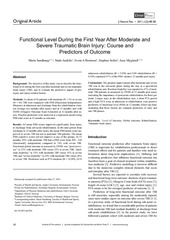| dc.contributor.author | Sandhaug, Maria | en_US |
| dc.contributor.author | Andelic, Nada | en_US |
| dc.contributor.author | Berntsen, Svein A. | en_US |
| dc.contributor.author | Seiler, Stephen | en_US |
| dc.contributor.author | Mygland, Åse | en_US |
| dc.date.accessioned | 2012-02-01T09:52:04Z | |
| dc.date.available | 2012-02-01T09:52:04Z | |
| dc.date.issued | 2011-06 | eng |
| dc.Published | Journal of Neurology Research 1(2): 48-58 | en |
| dc.identifier.issn | 1923-2845 | |
| dc.identifier.uri | https://hdl.handle.net/1956/5537 | |
| dc.description.abstract | Background: The objective of this study was to describe the functional level during the first year after moderate and severe traumatic brain injury (TBI), and to evaluate the predictive impact of pre-injury and injury-related factors. Methods: A cohort of 65 patients with moderate (N = 21) or severe (N = 44) TBI were examined with FIM (Functional Independence Measure) at admission and discharge from the rehabilitation clinic (on average two months after injury) and at 12 months, and with GOSE (Glasgow Outcome Scale Extended) at 12 months after injury. Possible predictors were analyzed in a regression model using FIM total score at 12 months as outcome. Results: All mean FIM scores improved significantly from injury to discharge from sub-acute rehabilitation. In the later period from discharge to 12 months after injury, the mean FIM motor score improved in severe TBI but not in moderate TBI patients. The mean FIM cognitive scores did not improve in any of the groups. At 12 months, 95% with moderate TBI had a FIM score from 109 - 126 (functionally independent) compared to 74% with severe TBI. Functional global outcome as assessed by GOSE was “good recovery” in 52% with moderate TBI versus 33% in severe TBI, “moderate disability” in 33% with moderate TBI versus 31% in severe TBI, and “severe disability” in 14% with moderate TBI versus 36% in severe TBI. Predictors such as PTA duration (B = -0.209), GCS admission rehabilitation (B = 5.058) and LOS rehabilitation (B = 0.458) explained 47% of the FIM variance 12 months post injury. Conclusions: The greatest improvement after moderate and severe TBI was in the sub-acute phase during the stay in a specialized rehabilitation unit. Residual disability was reported in 47% of moderate TBI patients as measured by GOSE at 12 months post injury indicating the importance of post-acute rehabilitation for these patients. Longer stays at the rehabilitation unit, a short PTA period and a high GCS score at admission to rehabilitation were positive predictors of functional level (FIM) at 12 months follow-up demonstrating that these factors are common predictors of early and late TBI phases. | en_US |
| dc.language.iso | eng | eng |
| dc.publisher | Elmer Press | eng |
| dc.relation.ispartof | <a href="http://hdl.handle.net/1956/5538" target="blank">Functional level after Traumatic Brain Injury</a> | eng |
| dc.rights | Attribution CC BY | eng |
| dc.rights.uri | http://creativecommons.org/licenses/by/3.0/ | eng |
| dc.subject | Rehabilitation | eng |
| dc.subject | Traumatic Brain Injury | eng |
| dc.title | Functional Level During the First Year After Moderate and Severe Traumatic Brain Injury: Course and Predictors of Outcome | en_US |
| dc.type | Peer reviewed | |
| dc.type | Journal article | |
| dc.description.version | publishedVersion | en_US |
| dc.rights.holder | Copyright the authors. All rights reserved | |
| dc.identifier.doi | https://doi.org/10.4021/jnr20w | |
| dc.subject.nsi | VDP::Medical disciplines: 700::Clinical medical disciplines: 750::Physical medicine and rehabilitation: 764 | eng |
| dc.subject.nsi | VDP::Medical disciplines: 700::Clinical medical disciplines: 750::Neurology: 752 | eng |

